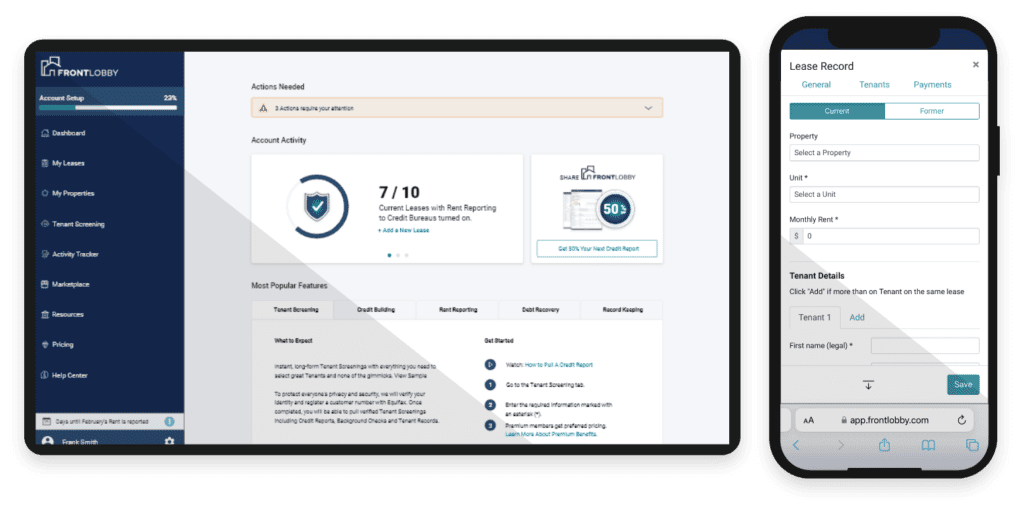10 Rental Documents Every Landlord Needs
Greet Your Tenants With Our Free Welcome Letter
- FrontLobby
- Published
- Updated July 18, 2023

Table of Contents
Why Should Landlords Keep Records?
What Rental Documents Every Landlord Should Have?
1) Rental Application
2) Tenant Screening Documents
3) Lease Agreement
4) Move-In and Move-Out Checklist
5) Lease Renewal
6) Notice of Lease Violation
7) Notice to Enter
8) Lease Termination
9) Eviction Notice
10) Lease Addendum
It is Important for Landlords to Keep Detailed Tenant Records
Landlords are often busy people. The list of things a Landlord is responsible for includes but is not limited to, collecting rent, maintaining the property, and communicating with Tenants. While some Landlords have full-time staff to help with these tasks, many do not. This can make it difficult for Landlords to keep up with everything that needs to be done.
Why Should Landlords Keep Records?
One of the most important things for a Landlord to do is to keep documentation. This documentation can include records of rent payments, maintenance requests, and Tenant agreements. Proper documentation can be extremely helpful if there is ever a problem that needs to be resolved.
If a Tenant stops paying rent, the Landlord will need to have documentation to show that they have not been making timely payments to begin the eviction process. If there is a problem with the property, the Landlord will need to have documentation of any communication with the Tenant about the issue to prove that they took reasonable steps to resolve it.
Keeping good documentation is essential for Landlords. It can help them avoid problems and resolve issues more quickly if problems do arise.
Bonus: Promote Transparency with Your Tenants
Creating and maintaining a respectful relationship with Tenants is a priority for Landlords. Providing your renters with detailed documentation throughout the duration of their tenancy encourages a mutually beneficial relationship.
Documentation can be used to welcome Tenants, explain expectations upfront, and streamline communication. By promoting transparency, Landlords start each Tenant relationship off on the right foot.
What Rental Documents Every Landlord Should Have?
A Landlord needs to protect their investment, and one way to do that is by having all the necessary rental documents in place. By having a signed lease agreement, Tenant application, and other pertinent forms, you can safeguard your interests while still providing Tenants with the security they need.
Regulations do vary by location, so always check laws applicable to your region. Here is a list of 10 rental documents every Landlord should have:
- Rental Application
- Tenant Screening Documents
- Lease Agreement
- Move-In and Move-Out Checklist (Welcome Letter)
- Lease Renewal
- Notice of Lease Violation
- Notice to Enter
- Lease Termination
- Eviction Notice
- Lease Addendum
Bonus: Documentation of any Correspondence with Tenants
1. Rental Application
The rental application is perhaps one of the most crucial documents a Landlord may have since it helps Landlords screen Tenants and identify the best-qualified prospects. It is used to collect information from potential Tenants such as their contact information, employment history, and rental history. Requiring a rental application may help prevent you from renting to an unqualified individual.
A typical rental application includes:
- Contact information
- References
- Current and previous residence information
- Employment history
- Proof of income
- Authorization to pull a credit report
There are several strategies to create a rental application, it is important to work with a trusted source to ensure you are following all legal requirements.
2. Tenant Screening Documents
Tenant screening documents are essential for Landlords to have to verify that an applicant is eligible and a good fit for the available listing. These documents can include things like a Tenant credit check, proof of income, and references from previous Landlords. By having these things on hand, Landlords can be sure that they are renting to responsible and trustworthy individuals.
Tenant Screening is a complex process filled with the burden of what can happen if you choose incorrectly. It is important to stay organized and follow a well-designed Tenant Screening process to help judge applicants with ease. Click here to read FrontLobby’s Tenant Screening Checklist for Landlords and Property Managers.
One of the most important documents when screening applications is a credit check. First, it can give Landlords an idea of the Tenant’s financial stability and ability to pay rent on time. Second, it can help Landlords avoid potential rental scams. And finally, it can help Landlords protect their property by screening out Tenant applicants with a history of undesirable behavior.
3. Lease Agreement
Lease agreements are important contracts that spell out the terms of a rental agreement between a Landlord and Tenant. Both the Landlord and Tenant should be clear about their rights and responsibilities under the lease. Having a written lease agreement can help avoid disputes between Landlords and Tenants and protect both parties’ rights.
Lease Agreement terms may vary, but should generally include:
- Landlord’s duty and rights
- Tenant’s responsibilities and rights
- Dates and terms of the lease
- Protection of property and Tenant accountability
- Payment terms, including what day rent is due and how to pay
- Outline the eviction process
Since a lease agreement is one of the most important documents it is important to consult local laws and regulations.
4. Move-In and Move-Out Checklist
As a Landlord, a move-in checklist helps you keep track of the condition of your rental unit before a new occupant moves in. This will help avoid misunderstandings and disputes later. The checklist should include:
- The condition of the floors, walls, and ceilings
- The condition of the windows, doors, and locks
- The condition of the plumbing fixtures and appliances
- Any defects or damage that is present in the unit
This rental document also provides Tenants with peace of mind by stating that you won’t charge for pre-existing damage. By providing your Tenants with this checklist, you can help avoid misunderstandings and ensure that your rental unit is well-maintained. At move-out, go over the list with your renters to see whether any damage has occurred beyond reasonable wear and tear.
Bonus: Include a welcome letter as part of your move-in checklist. It’s easy to forget that a welcoming letter will make your Tenant’s transition more pleasurable and help improve your Landlord-Tenant connection. It’s critical to check local rental rules before creating this kind of notice in order to be sure it is appropriate. You might include things like how to set up utilities, how to obtain Renters Insurance, and how to use the laundry. Click here to learn more about Landlord and Tenant maintenance responsibilities.
5. Lease Renewal
A lease renewal document is an important tool for Landlords. It allows the Landlord to extend the current lease agreement for another term, typically one year. This document will ensure both the Landlord and Tenant are still in agreement about the terms of the lease and that both parties are still happy with the arrangement.
Bonus: Lease renewals can help Landlords by eliminating the cost of finding new Tenants, reducing the cost of vacancies, and saving time spent trying to find a compatible Tenant. Contact your Tenant 90 days in advance of the expiration of their lease to see if they’d like to renew it. This will give you time to find a new Tenant if they do not wish to renew.

6. Notice of Lease Violation
A notice of lease violation is a document used by Landlords to inform Tenants that they have violated the terms of their lease agreement. This notice can be used for a variety of reasons, including but not limited to failure to pay rent, damage to property, or disruptive behavior. The Notice of Lease Violation will typically list the specific violation that has occurred and the date it occurred. It may also give the Tenant a deadline to remedy the situation or face further consequences, such as eviction. In some cases, the Notice of Lease Violation may also include a notice of lease termination.
7. Notice to Enter
A notice to enter is a written notice that a Landlord must give to a Tenant before entering the rental unit. The notice must state the date, time, and reason for the entry, this could be for repairs, inspections, or showings. In most cases, the Landlord must give the Tenant at least 24 hours’ notice before entering the unit.
There are some situations where the Landlord does not need to give advance notice, such as in an emergency. But in general, the Landlord should always try to give the Tenant as much notice as possible. If a Landlord does not use the proper form or fails to give adequate notice, the Tenant may have grounds to sue the Landlord.
8. Lease Termination
A lease termination document is a legal document that Landlords use to end a lease agreement. This document is important because it outlines the terms of the termination, including any notice that must be given and any final payments that are due. The lease termination document also releases both parties from any further obligations under the lease agreement.
There are a number of reasons why a Landlord might serve a lease termination to a Tenant. The most common reason is if the Tenant has violated the terms of the lease agreement, such as by failing to pay rent or causing damage to the property. It is important to note that Landlords cannot terminate a lease simply because they do not like the Tenant or because they want to rent the property to someone else for more money. If a Landlord tries to do this, the Tenant may be able to sue for wrongful eviction. If you have to terminate a lease for a renter, it is critical that you do so correctly.
9. Eviction Notice
An eviction notice is a notice from a Landlord to a Tenant that they must leave the property. There are a number of reasons a Landlord might choose to serve a Tenant with an eviction notice.
- Failure to pay rent
- Damage to the property
- Disruptive behavior
- Violating the terms of the lease agreement
Once an eviction notice has been served, the Tenant will have a certain amount of time to correct the issue or move out of the rental unit. If the Tenant does not take action, the Landlord can then file for eviction with the court.
There are a few ways that a Tenant can fight an eviction notice. If the Landlord does not have proper grounds for evicting the Tenant, or if they have not followed the proper legal procedures, the Tenant may be able to get the eviction notice overturned. Additionally, if the Tenant has a lease, they may be able to use it as a defense against eviction. Finally, Tenants can try to negotiate with the Landlord to try and come to an agreement that works for both parties.
Bonus: There are a few key differences between lease terminations and eviction notices. For one, eviction notices are usually only used if the Tenant has violated their lease agreement in some way, whereas a lease termination can be used for any reason. Additionally, an eviction notice must be served by a law enforcement officer or sheriff, whereas a lease termination does not have to be. Finally, if a Tenant is successfully evicted, they will likely have to pay damages to the Landlord, whereas with a lease termination they would not.
10. Lease Addendum
A lease addendum is an additional document that is added to an existing lease agreement. This document typically includes changes or additions to the original terms of the lease agreement. A Landlord might use a lease addendum to make changes to the rental property, such as adding new rules or regulations. A Tenant might use a lease addendum to request permission to make changes to the rental unit, such as painting the walls or installing new carpeting.
An example of a lease addendum would be a document that stipulates that a no smoking policy will be put into effect on the property. This would be an addition to the original lease agreement, which did not mention anything about smoking. Another example of a lease addendum would be a document that allows a Tenant to have a pet, even though the original lease agreement stated that pets were not allowed.
It is important to document any changes or additions to a lease agreement, as this can help prevent disputes between Landlords and Tenants. A lease addendum should be signed by both the Landlord and the Tenant, and each party should keep a copy of the document for their records.
It is Important for Landlords to Keep Detailed Tenant Records
It is important for Landlords to keep documentation of everything related to their rental property. This includes keeping track of rent payments, maintenance and repair records, and any communications with Tenants. Being organized and keeping good records will help Landlords in the event that they need to take legal action against a Tenant or make a claim on their rental property insurance.
If you are a Landlord, it is important to use proper legal forms and keep documentation of everything related to your rental property. Being organized and keeping good records will help protect you from potential risks, such as:
- A claim that a Tenant did not receive notice of any important changes or updates
- A claim that you did not follow proper procedures when terminating a lease
- A complaint filed with the local housing authority if a Tenant feels their rights have been violated
- A claim on their rental property insurance
It is always best to err on the side of caution and use the proper legal forms whenever possible. This will help ensure that both you and your Tenant are protected throughout the duration of the lease agreement.
Disclaimer
The information provided in this post is not intended to be construed as legal advice, nor should it be considered a substitute for obtaining individual legal counsel or consulting your local, state, federal or provincial tenancy laws.
Did You Enjoy This Article?
Then You Will Love Our Newsletter


